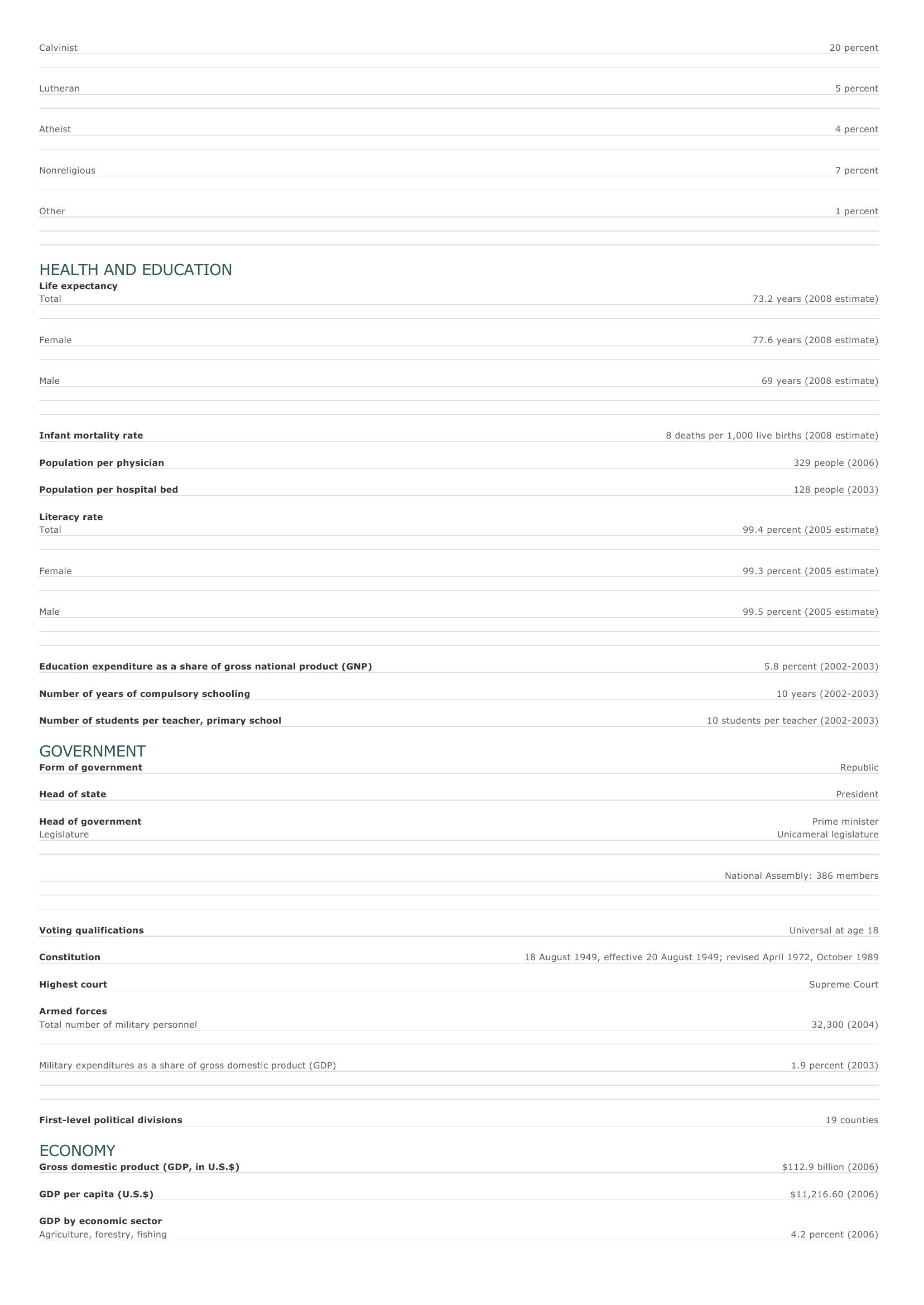Hungary Facts and Figures. BASIC FACTS Official name Capital Area Republic of Hungary Budapest 93,030 sq km 35,919 sq mi PEOPLE Population 9,930,915 (2008 estimate) Population growth Population growth rate -0.25 percent (2008 estimate) Projected population in 2025 9,437,569 (2025 estimate) Projected population in 2050 8,374,619 (2050 estimate) Population density 108 persons per sq km (2008 estimate) 278 persons per sq mi (2008 estimate) Urban/rural distribution Share urban 66 percent (2005 estimate) Share rural 34 percent (2005 estimate) Largest cities, with population Budapest 1,708,000 (2003 estimate) Debrecen 206,564 (2002 estimate) Miskolc 182,408 (2002 estimate) Szeged 163,699 (2002 estimate) Pécs 159,794 (2002 estimate) Ethnic groups Hungarian (Magyar) 89.9 percent Roma (Gypsy) 4.0 percent G erman 2.6 percent Serbian 2.0 percent Slovak 0.8 percent Romanian 0.7 percent Languages Hungarian (Magyar) (official) O ther Religious affiliations Roman Catholic 98.2 percent 1.8 percent 63 percent Calvinist 20 percent Lutheran 5 percent Atheist 4 percent Nonreligious 7 percent O ther 1 percent HEALTH AND EDUCATION Life expectancy Total 73.2 years (2008 estimate) Female 77.6 years (2008 estimate) Male Infant mortality rate 69 years (2008 estimate) 8 deaths per 1,000 live births (2008 estimate) Population per physician 329 people (2006) Population per hospital bed 128 people (2003) Literacy rate Total 99.4 percent (2005 estimate) Female 99.3 percent (2005 estimate) Male 99.5 percent (2005 estimate) Education expenditure as a share of gross national product (GNP) Number of years of compulsory schooling Number of students per teacher, primary school 5.8 percent (2002-2003) 10 years (2002-2003) 10 students per teacher (2002-2003) GOVERNMENT Form of government Head of state Head of government Legislature Republic President Prime minister Unicameral legislature National Assembly: 386 members Voting qualifications Constitution Highest court Universal at age 18 18 August 1949, effective 20 August 1949; revised April 1972, October 1989 Supreme Court Armed forces Total number of military personnel Military expenditures as a share of gross domestic product (GDP) First-level political divisions 32,300 (2004) 1.9 percent (2003) 19 counties ECONOMY Gross domestic product (GDP, in U.S.$) GDP per capita (U.S.$) $112.9 billion (2006) $11,216.60 (2006) GDP by economic sector Agriculture, forestry, fishing 4.2 percent (2006) I ndustry 30.1 percent (2006) Services 65.7 percent (2006) Employment Number of workers Workforce share of economic sector Agriculture, forestry, fishing 4,202,441 (2006) 5 percent (2005) I ndustry 32 percent (2005) Services 63 percent (2005) Unemployment rate 6.1 percent (2004) National budget (U.S.$) Total revenue $40,436 million (2006) Total expenditure $49,787 million (2006) Monetary unit 1 forint (Ft), consisting of 100 filler Major trade partners for exports Germany, Austria, Italy, France, and United States Major trade partners for imports Germany, Italy, Austria, Russia, and France ENERGY, COMMUNICATIONS, AND TRANSPORTATION Electricity production Electricity from thermal sources Electricity from hydroelectric sources Electricity from nuclear sources Electricity from geothermal, solar, and wind sources 66.76 percent (2003 estimate) 0.52 percent (2003 estimate) 32.47 percent (2003 estimate) 0.25 percent (2003 estimate) Number of radios per 1,000 people 690 (1997) Number of telephones per 1,000 people 333 (2005) Number of televisions per 1,000 people 438 (2000 estimate) Number of Internet hosts per 10,000 people 358 (2003) Daily newspaper circulation per 1,000 people 465 (1998) Number of motor vehicles per 1,000 people 313 (2003) Paved road as a share of total roads 44 percent (2003) SOURCES Basic Facts and People sections Area data are from the statistical bureaus of individual countries. Population, population growth rate, and population projections are from the United States Census Bureau, International Programs Center, International Data Base (IDB) (www.census.gov). Urban and rural population data are from the Food and Agriculture Organization (FAO) of the United Nations (UN), FAOSTAT database (www.fao.org). Largest cities population data and political divisions data are from the statistical bureaus of individual countries. Ethnic divisions and religion data are largely from the latest Central Intelligence Agency (CIA) World Factbook and from various country censuses and reports. Language data are largely from the Ethnologue, Languages of the World, Summer Institute of Linguistics International (www.sil.org). Health and Education section Life expectancy and infant mortality data are from the United States Census Bureau, International Programs Center, International database (IDB) (www.census.gov). Population per physician and population per hospital bed data are from the World Health Organization (WHO) (www.who.int). Education data are from the United Nations Educational, Scientific and Cultural Organization (UNESCO) database (www.unesco.org). Government section Government, independence, legislature, constitution, highest court, and voting qualifications data are largely from various government Web sites, the latest Europa World Yearbook, and the latest Central Intelligence Agency (CIA) World Factbook. The armed forces data is from Military Balance. Economy section Gross domestic product (GDP), GDP per capita, GDP by economic sectors, employment, and national budget data are from the World Bank database (www.worldbank.org). Monetary unit, agriculture, mining, manufacturing, exports, imports, and major trade partner information is from the statistical bureaus of individual countries, latest Europa World Yearbook, and various United Nations and International Monetary Fund (IMF) publications. Energy, Communication, and Transportation section Electricity information is from the Energy Information Administration (EIA) database (www.eia.doe.gov). Radio, telephone, television, and newspaper information is from the United Nations Educational, Scientific and Cultural Organization (UNESCO) database (www.unesco.org). Internet hosts, motor vehicles, and road data are from the World Bank database (www.worldbank.org). Note Figures may not total 100 percent due to rounding. Microsoft ® Encarta ® 2009. © 1993-2008 Microsoft Corporation. All rights reserved.





















